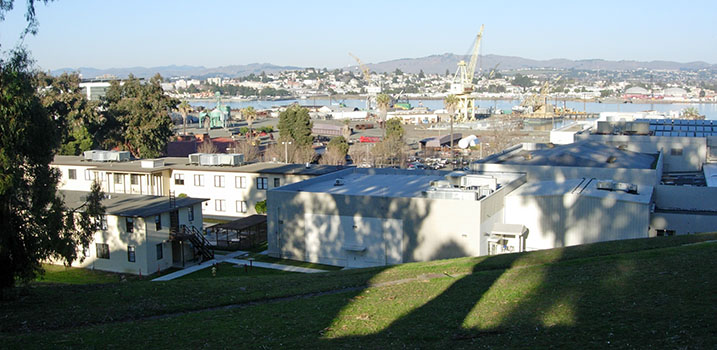Mare Island is a 3.5-mile long promontory-sometimes a peninsula, sometimes an island-located in the northeast corner of San Pablo Bay.

The Mare Island Naval Shipyard was the first US Navy base established on the West Coast in 1854. 513 ships and 17 nuclear submarines were built on Mare Island before the base closed in 1996. Photo by Joel Williams
By Captain Ray
Published: July, 2015
Mare Island is a 3.5-mile long promontory—sometimes a peninsula, sometimes an island—located in the northeast corner of San Pablo Bay. To the east of the island is the Napa River and to the west is San Pablo Bay. It is the rising and falling of tides in the northern sloughs that change its status from island to peninsula and back.
The Patwin (the southern branch of the Wintun band of native Californians) were present on the island for several thousand years, living in the area that is now Vacaville and Suisun and perhaps as far north as Putah Creek. In the summer of 1775, the Spanish explorer Juan Manuel de Ayala, the first European to land on the island, claimed it for Spain and named it Isla de la Plana, or “Flat Island.”
In 1843, Rancho Suscol (of which Isla de la Plana was a part) was granted to General Mariano Guadalupe Vallejo, the Mexican Commandante of Alta California. Local lore says that it was Vallejo himself who renamed the island Isla de la Yegua, or “Mare Island,” when a prized white mare—feared lost and drowned during a ferry crossing of Carquinez Strait—was found alive and well on the island several days later.
In 1846, hostilities broke out between Mexico and the United States. With the signing of the Treaty of Guadalupe Hidalgo in 1848, Alta California passed into American hands. The United States now needed to build, equip and support a two-ocean navy. Commodore John Sloat (for whom Sloat Boulevard in San Francisco and Sloat Avenue in Monterey are named) had landed in Monterey and seized it for the United States. He was next charged with finding a site for the first U.S. naval base on the West Coast. He recommended Mare Island because it was “free from ocean gales and from floods and freshets.”
Within a few months of California’s statehood in September 1850, President Millard Fillmore “reserved” Mare Island for the Navy. In 1852, the United States purchased the island from the State of California. The United States Naval Shipyard opened on September 16, 1854, with Commodore David Farragut (famous for giving the order “Damn the torpedoes! Full speed ahead!” at the Battle of Mobile Bay during the U.S. Civil War) serving as its first commanding officer.
Piers and drydocks were constructed and the island was linked to Vallejo with a causeway. As it grew, administration buildings, warehouses, a paint shop, ammunition magazines, foundries, machine shops and naval architect offices were added. In total, the yard constructed 513 ships, including the navy’s first aircraft carrier in 1912 and the battleship USS California (the only battleship ever built on the West Coast) in 1919.
The launch of the California was particularly memorable because as she slid down the ways and into the waters of Mare Island Strait, the restraining cables failed. The momentum of her 32,000 tons carried her across the river and into the Georgia Street Pier, where she sank several boats. During the early summer of 1918, the shipyard built the destroyer USS Ward in just 17.5 days from laying the keel to launching the ship—a construction record that still stands! In addition, the yard built 17 nuclear submarines and repaired 1,227 ships, sometimes handling six large naval vessels at the same time. During World War II, the shipyard employed more than 40,000 people, including 9,000 women.
In next month’s edition of Bay Crossings, I’ll finish the story of this island and its remarkable history.
Ray Wichmann, is a US SAILING-certified Ocean Passagemaking Instructor, a US SAILING Master Instructor Trainer, and a member of US SAILING’s National Faculty. He holds a 100-Ton Master’s License, was a charter skipper in Hawai’i for 15 years, and has sailed on both coasts of the United States, in Mexico, the Caribbean and Greece. He is presently employed as the Master Instructor at OCSC Sailing in the Berkeley Marina.

